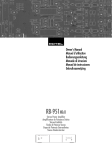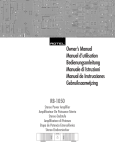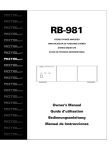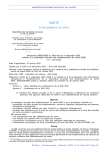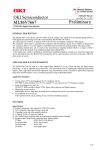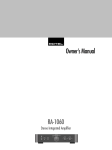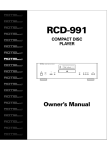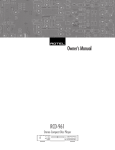Download Rotel RB-951 mkII Owner`s manual
Transcript
Owner’s Manual RB-951 MkII Stereo Power Amplifier POWER AMPLIFIER RB-951 MkII CH1 CH2 PROTECTION POWER BRIDGED MONO CLIPPING LEVEL LEVEL RB-951 MkII Stereo Power Amplifier English 2 1: Controls, Connections, & Internal Jumpers POWER AMPLIFIER RB-951 MkII CH1 CH2 PROTECTION POWER BRIDGED MONO CLIPPING LEVEL 1 2 LEVEL 3 6 7 8 12 TRIG IN CAUTION 4 9 AVIS: RISQUE DE CHOC ELECTRIQUE–NE PAS OUVRIR TO REDUCE THE RISK OF FIRE OR ELECTRICAL SHOCK, DO NOT EXPOSE THIS EQUIPMENT TO RAIN OR MOISTURE. BRIDGED MONO 10 A SPEAKERS CHANNEL 2 CHANNEL 1 INPUT CH2 CH1 WARNING: OFF CH2 NORMAL STEREO 11 CH1 BRIDGED SIGNAL OUTPUT LINK 12 13 AC BREAKER POWER AMPLIFIER MODEL NO. RB-951 MkII POWER CONSUMPTION: 200W RB-951 P2 P3 P1 123 123 123 S603 S602 S604 123 123 S605 S606 Default Jumper settings shown in illustration. 10 SIGNAL SENSE STEREO: 4 OHMS MINIMUM BRIDGED: 8 OHMS MINIMUM RISK OF ELECTRIC SHOCK DO NOT OPEN 5 MkII 3 2: Hookup (Stereo or Parallel Mono modes) RCA OUTPUTS R L 12 TRIG IN CAUTION SIGNAL SENSE RISK OF ELECTRIC SHOCK DO NOT OPEN 10 A AVIS: RISQUE DE CHOC ELECTRIQUE–NE PAS OUVRIR INPUT CH2 CH1 WARNING: TO REDUCE THE RISK OF FIRE OR ELECTRICAL SHOCK, DO NOT EXPOSE THIS EQUIPMENT TO RAIN OR MOISTURE. BRIDGED MONO NORMAL STERO SPEAKERS CHANNEL 2 CHANNEL 1 OFF CH2 BRIDGED CH1 SIGNAL OUTPUT LINK AC BREAKER POWER AMPLIFIER MODEL NO. RB-951 MkII POWER CONSUMPTION: 200W RB-951 MkII RB-951 MkII Stereo Power Amplifier 4 3: Hookup (Bridged Mono mode) RCA OUTPUTS R L 12 TRIG IN CAUTION SIGNAL SENSE RISK OF ELECTRIC SHOCK DO NOT OPEN 10 A AVIS: RISQUE DE CHOC ELECTRIQUE–NE PAS OUVRIR INPUT CH2 CH1 WARNING: TO REDUCE THE RISK OF FIRE OR ELECTRICAL SHOCK, DO NOT EXPOSE THIS EQUIPMENT TO RAIN OR MOISTURE. BRIDGED MONO NORMAL STERO SPEAKERS CHANNEL 2 CHANNEL 1 OFF CH2 POWER AMPLIFIER MODEL NO. RB-951 MkII POWER CONSUMPTION: 200W RB-951 SIGNAL OUTPUT LINK BRIDGED 12 TRIG IN CAUTION CH1 MkII SIGNAL SENSE RISK OF ELECTRIC SHOCK DO NOT OPEN 10 A AVIS: RISQUE DE CHOC ELECTRIQUE–NE PAS OUVRIR INPUT CH2 CH1 WARNING: TO REDUCE THE RISK OF FIRE OR ELECTRICAL SHOCK, DO NOT EXPOSE THIS EQUIPMENT TO RAIN OR MOISTURE. BRIDGED MONO AC BREAKER NORMAL STERO SPEAKERS CHANNEL 2 CHANNEL 1 OFF CH2 BRIDGED CH1 SIGNAL OUTPUT LINK AC BREAKER POWER AMPLIFIER MODEL NO. RB-951 MkII POWER CONSUMPTION: 200W RB-951 MkII English 5 WARNING: There are no user serviceable parts inside. Refer all servicing to qualified service personnel. WARNING: To reduce the risk of fire or electric shock, do not expose the unit to moisture or water. Do not allow foreign objects to get into the enclosure. If the unit is exposed to moisture, or a foreign object gets into the enclosure, immediately disconnect the power cord from the wall. Take the unit to a qualified service person for inspection and necessary repairs. Read all the instructions before connecting or operating the component. Keep this manual so you can refer to these safety instructions. Heed all warnings and safety information in these instructions and on the product itself. Follow all operating instructions. Clean the enclosure only with a dry cloth or a vacuum cleaner. You must allow 10 cm or 4 inches of unobstructed clearance around the unit. Do not place the unit on a bed, sofa, rug, or similar surface that could block the ventilation slots. If the component is placed in a bookcase or cabinet, there must be ventilation of the cabinet to allow proper cooling. Keep the component away from radiators, heat registers, stoves, or any other appliance that produces heat. The unit must be connected to a power supply only of the type and voltage specified on the rear panel of the unit. Connect the component to the power outlet only with the supplied power supply cable or an exact equivalent. Do not modify the supplied cable in any way. Do not attempt to defeat grounding and/or polarization provisions. Do not use extension cords. Do not route the power cord where it will be crushed, pinched, bent at severe angles, exposed to heat, or damaged in any way. Pay particular attention to the power cord at the plug and where it exits the back of the unit. The power cord should be unplugged from the wall outlet if the unit is to be left unused for a long period of time. Immediately stop using the component and have it inspected and/ or serviced by a qualified service agency if: • The power supply cord or plug has been damaged. • Objects have fallen or liquid has been spilled into the unit. • The unit has been exposed to rain. • The unit shows signs of improper operation • The unit has been dropped or damaged in any way Place the unit on a fixed, level surface strong enough to support its weight. Do not place it on a moveable cart that could tip over. RB-951 MkII Stereo Power Amplifier Contents 6 Speakers ................................................ 9 1: Controls, Connections, & Internal Jumpers 2 2: Hookup (Stereo or Parallel Mono modes) 3 3: Hookup (Bridged Mono mode) 4 About Rotel ........................................... 6 Getting Started ...................................... 7 Operating Features 7 A Few Precautions 7 Placement 7 AC Power and Control ............................ 7 Speaker Selection 9 Speaker Wire Selection 9 Polarity and Phasing 9 Speaker Connections 9 Internal Jumper Settings for Custom Installation ......................... 10 Bypassing the Variable Level Controls (S603 and S604) 10 Input Sensitivity (S605 and S606) 10 Selecting Parallel Mono Mode (S602 and P1/P3) 10 AC Power Input 7 Power Switch and Indicator 7 Troubleshooting .................................... 10 Auto Turn On/Off Mode Selector 7 Front Panel Power Indicator Is Not Lit 10 12V Trigger Input 8 No Sound 10 Circuit Breaker 8 Protection Indicator Is Lit 10 Protection Indicators 8 Specifications ....................................... 11 Stereo/Mono Mode Selection ................. 8 Bridge Switch and Front Panel Bridge LED 8 Signal Connections .................................. 8 RCA Inputs 8 Input Level Controls 8 Clipping Indicators 9 Signal Output Link 9 About Rotel A family whose passionate interest in music led them to manufacture high fidelity components of uncompromising quality founded Rotel over 30 years ago. Over the years that passion has remained undiminished and the goal of providing exceptional value for audiophiles and music lovers regardless of their budget, is shared by all Rotel employees. The engineers work as a close team, listening to, and fine tuning each new product until it reaches their exacting musical standards. They are free to choose components from around the world in order to make that product the best they can. You are likely to find capacitors from the United Kingdom and Germany, semiconductors from Japan or the United States, and toroidal power transformers manufactured in Rotel’s own factory. Rotel’s reputation for excellence has been earned through hundreds of good reviews and awards from the most respected reviewers in the industry, who listen to music every day. Their comments keep the company true to its goal – the pursuit of equipment that is musical, reliable and affordable. All of us at Rotel thank you for buying this product and hope it will bring you many hours of enjoyment. 7 Getting Started Thank you for purchasing the Rotel RB-951MkII Stereo Power Amplifier. When used in a highquality music or home theater system, your Rotel amplifier will provide years of musical enjoyment. The RB-951MkII is a sophisticated two-channel power amplifier. Discrete output devices, a massive power supply with toroidal transformer, premium components, and Rotel’s Balanced Design ensure superb sound quality. High current capability allows the RB-951MkII to drive difficult speaker loads with ease. Placement Power Switch and Indicator The RB-951MkII generates heat as part of its normal operation. The heat sinks and ventilation openings in the amplifier are designed to dissipate this heat. The ventilation slots in the top cover must be unobstructed. There should be 10 cm (4 inches) of clearance around the chassis, and reasonable airflow through the installation location, to prevent the amplifier from overheating. The power switch is located on the left side of the front panel. To turn the amplifier on (or to activate either of the optional automatic power-on modes), push the switch in. The LED indicator above the switch will light, indicating that the amplifier is turned on. To turn the amplifier off, push the button again and return it to the out position. Likewise, remember the weight of the amplifier when you select an installation location. Make sure that the shelf or cabinet can support its considerable bulk. Again, use common sense. Operating Features • Two-channel Stereo or Bridged Mono operation (back panel switchable) • Optional Parallel Mono operation for driving low impedance multi-speaker loads in custom installation applications (requires resetting internal jumpers). • User-selectable power on/off configuration: manual, automatic signal sensing, or controlled by remote 12 volt trigger signal. • Front panel input level controls • Protection circuitry with front panel indicators • Front panel clipping indicators A Few Precautions Please read this manual carefully. In addition to basic installation and operating instructions, it provides valuable information on various RB-951MkII system configurations as well as general information that will help you get optimum performance from your system. Please contact your authorized Rotel dealer for answers to any questions you might have. In addition, all of us at Rotel welcome your questions and comments. Save the RB-951MkII shipping carton and all enclosed packing material for future use. Shipping or moving the RB-951MkII in anything other than the original packing material may result in severe damage to your amplifier. Be sure to keep the original sales receipt. It is your best record of the date of purchase, which you will need in the event warranty service is ever required. English AC Power and Control AC Power Input The RB-951MkII is supplied with the proper AC power chord. Use only this cord or an exact equivalent. Do not use an extension cord. A heavy duty multi-tap power outlet strip may be used, but only if it is rated to handle the current demanded by the RB-951MkII. Be sure the power switch on the front panel of the RB-951MkII is turned off. Then, plug one end of the cord into the AC power connector on the back panel of the amplifier. Plug the other end into an appropriate AC outlet. Your RB-951MkII is configured at the factory for the proper AC line voltage in the country where you purchased it (USA: 115 volts/60 Hz , Europe: 230 volts/50 Hz). The AC line configuration is noted on a label on the back panel. NOTE: Should you move your RB-951MkII to another country, it is possible to configure your amplifier for use on a different line voltage. Do not attempt to perform this conversion yourself. Opening the enclosure of the RB-951MkII exposes you to dangerous voltages. Consult a qualified technician or the Rotel factory service department for information. If you are going to be away from home for an extended period of time, it is a sensible precaution to unplug your amplifier. Auto Turn On/Off Mode Selector The RB-951MkII provides three different options for manual or automatic power on/off operation. These modes are selectable using a threeposition slide switch on the back panel as follows: • With the switch in the OFF position, the amplifier is turned on or off manually using the front panel power switch. Also use this mode if you are using a switched AC outlet to control power to the amplifier. • With the switch in the SIGNAL SENSING position, the amplifier turns on automatically when a signal is sensed at the inputs. The amplifier will go into standby mode five minutes after no signal is present. The front panel power switch overrides this function. It must be ON for the signal sensing to work. Turning the switch OFF cuts power to the amplifier, regardless of whether or not a signal is present. • With the switch in the +12V TRIG. IN position, the amplifier is turned on automatically when a 12 volt trigger signal is present at the screw terminals adjacent to the left of the switch. The amplifier will go into standby mode if the +12 volt signal is not present. The front panel POWER SWITCH overrides this function. It must be ON for the +12V trigger to work. Turning the switch OFF cuts power to the amplifier, regardless of whether or not a trigger signal is present. RB-951 MkII Stereo Power Amplifier 12V Trigger Input A pair of screw terminals for connecting the wires carrying a +12 volt trigger signal to turn the amplifier on and off, such as might be used in an elaborate custom installation. To use this feature the adjacent slide switch must be placed to the left position (see previous section). The TRIGGER INPUT accepts any control signal (AC or DC) ranging from 3 volts to 30 volts. The screw terminals are labeled “+ and –” Observe proper polarity when connecting the trigger signal wiring. Circuit Breaker A circuit breaker on the rear panel protects the amplifier’s electrical circuity. Generally, the circuit breaker will only open under a fault condition which results in excessive current draw. To reset the circuit breaker, press the button. Should it repeatedly open, contact your authorized Rotel dealer for troubleshooting assistance. Protection Indicators A thermal protection circuit protects the amplifier against potential damage in the event of extreme or faulty operating conditions. Unlike many designs, the RB-951MkII’s protection circuit is independent of the audio signal and has no impact on sonic performance. Instead, the protection circuit monitors the temperature of the output devices and shuts down the amplifier if temperatures exceed safe limits. In addition, the RB-951MkII includes overcurrent protection which operates only when load impedances drops too low. This protection is independent for the left and right channels with separate front panel PROTECTION LEDS for each. Should a faulty condition arise, the amplifier will stop playing and the PROTECTION LEDS on the front panel will light. If this happens, turn the amplifier off, let it cool down for several minutes, and attempt to identify and correct the problem. When you turn the amplifier back on, the protection circuit will automatically reset and the PROTECTION LEDS should go out. 8 In most cases, the protection circuitry activates because of a fault condition such as shorted speaker wires, or inadequate ventilation leading to an overheating condition. In very rare cases, highly reactive or extremely low impedance speaker loads could cause the protection circuit to engage. Stereo/Mono Mode Selection The RB-951MkII provides three options for Stereo or Bridged Mono operation. • Stereo mode: Conventional 2-channel stereo operation. Minimum speaker load: 4 ohms. • Bridged Mono mode: Serial bridged mode which more than doubles the amplifier power into a single speaker. Minimum speaker load: 8 ohms. • Parallel Mono mode: A special bridge mode that allows the amplifier to drive extremely low impedance speaker loads such as might be encountered driving multiple speakers in a custom installation. Minimum speaker load: 2 ohms. The first two modes are selected using a rear panel switch. The Parallel Mono mode requires setting internal jumpers and should only be done by a qualified technician. See the INTERNAL JUMPER SETTINGS section at the end of this manual. Signal Connections The RB-951MkII provides standard conventional input connections — unbalanced RCA type connections as found on nearly all audio equipment. In addition, there is a pair of SIGNAL OUTPUT LINK connections for passing the unchanged input signal on to another audio component. RCA Inputs See Figures 2 and 3 These RCA inputs accept audio signals from preamplifiers or surround sound processors. Use high quality audio interconnect cables for best performance. For Stereo operation, use both inputs. Connect the left channel output of your preamp to the CH 1 INPUT on the RB-951MkII. Connect the right channel of your preamp to the CH 2 INPUT. Make sure that the BRIDGE SWITCH is in the NORMAL STEREO position. For Bridged Mono operation, use only the CH1 INPUT. Connect one output channel of your preamp to the CH 1 INPUT on the RB-951MkII. Connect the other channel of your preamp to a second amplifier. Make sure that the BRIDGE SWITCH selector switch is in the BRIDGED MONO position. For Parallel Mono operation, either input may be used. The signal from either will be sent to all speaker outputs. Input Level Controls Bridge Switch and Front Panel Bridge LED A rear panel switch selects Stereo mode or Bridged Mono mode. For Stereo mode: Slide the switch to the right, use both input connectors, and connect one speaker to each pair of speaker connectors. The front panel LED will be extinguished. For Bridged Mono mode: Slide the switch to the left, use only the CH1 INPUT connection, and connect only one speaker to the two outer speaker connectors. The front panel LED will light to indicate Bridged Mono mode. Two recessed controls on the front panel, one for each channel, provide input level adjustments. These allow you to adjust the gain of the amplifier to match other components in an elaborate system. The CH1 level control changes the gain of the left channel; the CH2 level control changes the right channel. To adjust these controls, use a small, flat-blade screwdriver. Turn the control clockwise to increase gain. Turn counterclockwise to reduce gain. NOTE: These controls may be disabled by resetting an internal jumper. 9 Clipping Indicators Speaker Wire Selection Two front panel LEDs (one for each channel) flash to indicate when the amplifier is “clipping” or being asked to deliver more output current than it is capable of delivering. Clipping will cause distortion levels to increase. Use insulated two-conductor stranded wire to connect the RB-951MkII to the speakers. The size and quality of the wire can have an audible effect on the performance of the system. Standard speaker wire will work, but can result in lower output or diminished bass response, particularly over longer distances. In general, heavier wire will improve the sound. For best performance, you may want to consider special high-quality speaker cables. Your authorized Rotel dealer can help in the selection of appropriate cables for your system. Occasional brief clipping on the loudest musical passages is acceptable. However, sustained or frequent clipping is one of the most common causes of speaker damage and should be avoided. Should this occur, either reduce the overall gain of the system by turning down the master volume control on your preamp. Alternatively, you may wish to permanently reduce the gain of the amplifier using the front panel level controls (see previous section). Signal Output Link This pair of RCA connections can be used to pass the unprocessed input signals to another audio component, for example to “daisy-chain” an additional amplifier to drive a second set of speakers. Any INPUT SIGNAL is also available at these LINK outputs. Speakers The RB-951MkII has two pair of speaker connectors, one pair for each channel. These can be used to connect two loudspeakers in Stereo mode, or to connect one loudspeaker in Bridged Mono mode. Speaker Selection The nominal impedance of the loudspeaker(s) connected to the RB-951MkII in the various operating modes should be: • Stereo mode: minimum 4 ohms • Bridged Mono mode: minimum 8 ohms • Parallel Mono mode: minimum 2 ohms When driving multiple pairs of speakers connected in parallel, the effective impedance the amplifier sees is cut in half. For example, when driving two pair of 8 ohm speakers, the amplifier sees a 4 ohm load. When driving multiple speakers in parallel, select speakers with a nominal impedance of 8 ohms or higher. Polarity and Phasing The polarity – the positive/negative orientation of the connections – for every speaker and amplifier connection must be consistent so all the speakers will be in phase. If the polarity of one connection is mistakenly reversed, bass output will be very weak and stereo imaging degraded. All wire is marked so you can identify the two conductors. There may be ribs or a stripe on the insulation of one conductor. The wire may have clear insulation with different color conductors (copper and silver). There may be polarity indications printed on the insulation. Identify the positive and negative conductors and be consistent with every speaker and amplifier connection. Speaker Connections See Figures 2 & 3 The RB-951MkII has one pair of color coded connections per channel. Labels above the connectors show the proper connections for Stereo mode. Labels below show the proper connections for Bridged Mono mode. These speaker connectors accept bare wire, connector lugs, or “banana” type connectors (except in the European Community countries where their use is not permitted). Route the wires from the RB-951MkII to the speakers. Give yourself enough slack so you can move the components enough to allow access to the speaker connectors. English If you are using banana plugs, connect them to the wires and then plug into the backs of the speaker connectors. The collars of the speaker connectors should be screwed in all the way (clockwise). If you are using terminal lugs, connect them to the wires. If you are attaching bare wires directly to the speaker connectors, separate the wire conductors and strip back the insulation from the end of each conductor. Be careful not to cut into the wire strands. Unscrew (turn counterclockwise) the speaker connector collar. Place the connector lug around the shaft, or insert the bundled wire into the hole in the shaft. Turn the collars clockwise to clamp the connector lug or wire firmly in place. NOTE: Be sure there are no loose wire strands that could touch adjacent wires or connectors. In Stereo mode: Connect the left speaker to the pair of speaker connectors labeled CH1. Connect the right speaker to the speaker connectors labeled CH2. Follow the labels printed above the connectors and make sure the BRIDGE MODE switch is set to the NORMAL STEREO position. (See Figure 2) In Bridged Mono mode: Connect the positive terminal of the speaker to the speaker connector labeled BRIDGE +. Connect the negative terminal of the speaker to the speaker connector labeled BRIDGE –. Follow the labels printed below the connectors and make sure the BRIDGE switch is set to the BRIDGE MONO position. (See Figure 3) In Parallel Mono mode: Connect the speakers in the same fashion as in the Stereo mode. You can use the connectors for either channel or both – the same output signal is present at both pair of connectors. (See Figure 2) RB-951 MkII Stereo Power Amplifier Internal Jumper Settings for Custom Installation (see figure 1) There are internal jumpers that can be used to disable the front panel level controls, to select one of two input sensitivity settings, and to engage the special Parallel Mono mode for driving low impedance speaker combinations in custom installations. WARNING: Removing the top cover of the amplifier to access the jumpers may expose you to potentially dangerous voltages. These settings should only be made by a qualified technician. The AC power cord must be removed from the amplifier before the top cover is removed. After removing the top cover, the jumper blocks can be found on the circuit board as shown in Figure 1. Each jumper block has a printed identification number. The function, ID numbers, and settings for each jumper block are provided below. To change the setting, place the jumper on the appropriate pins as indicated. Bypassing the Variable Level Controls (S603 and S604) The front panel Level Controls allow you to adjust the input gain for each channel of the amplifier. These level controls can by bypassed by changing the jumper position on jumper blocks S603 (for CH 1) and S604 (for CH2). To disable the variable level controls: place a jumper across pins 2 and 3 on jumper block S603 and across pins 1 and 2 on jumper block S604. To enable the variable level controls: place a jumper across pins 1 and 2 on jumper block S603 and across pins 2 and 3 on jumper block S604. 10 Input Sensitivity (S605 and S606) Troubleshooting Jumper blocks S605 and S606 are used to set the input sensitivity of the amplifier. Most difficulties in audio systems are the result of poor or wrong connections, or improper control settings. If you encounter problems, isolate the area of the difficulty, check the control settings, determine the cause of the fault and make the necessary changes. If you are unable to get sound from the RB-951MkII, refer to the suggestions for the following conditions: For high sensitivity (0.775v input for rated power): place the jumpers across pins 1 and 2 on jumper blocks S605 and S606. For low sensitivity (1.5v input for rated power): place the jumpers across pins 2 and 3 on jumper blocks S605 and S606. Selecting Parallel Mono Mode (S602 and P1/P3) As described earlier in this manual, the two most common operating configurations for the RB-951MkII (Stereo mode and Bridged Mono mode) are selectable with a back panel switch and require no internal changes. The third configuration, Parallel Mono mode, allows both channels of the amplifier to be combined in parallel. This mode is useful for driving a low impedance speaker load such as driving multiple speakers in a custom installation. This Parallel Mono mode can be selected only by setting internal jumpers (jumper block S602) and changing a buss wire connection (connectors P1and P2). NOTE: it is essential that Parallel Mono mode not be engaged at the same time as Stereo mode. This will blow the internal rail fuses. Make sure that you follow all of the instructions below carefully. To convert to Parallel Mono mode: 1. Place the jumper across pins 1 and 2 on jumper block S602. 2. Locate the buss wire linking the P2 connector to the P3 connector. Remove the wire from P3 and move it to the adjacent P1 connector. For Parallel Mono mode, the buss wire must link P2 to P1. To return to normal configuration (Stereo or Bridged Mono modes): 1. Place the jumper across pins 2 and 3 on jumper block S602. 2. Locate the buss wire linking the P2 connector to the P1 connector. Remove the wire from P1 and move it to the adjacent P3 connector. For normal mode, the buss wire must link P2 to P3. Front Panel Power Indicator Is Not Lit No main power to the RB-951MkII. Check AC power connections at the amplifier and the AC outlet. Check the front panel power switch. Make sure that it is set to the ON position. If using signal sensing auto power-on, make sure that a signal is present at the inputs. If using 12V trigger power-on, make sure that a trigger signal is present at rear panel screw terminals. No Sound If the amp is getting AC power, but is producing no sound, check the PROTECTION INDICATORS on the front panel. If lit, see below. If not, check all of your connections and control settings on associated components. Make sure that your input connections and speaker connections match your selected stereo/mono configuration. Protection Indicator Is Lit The front panel PROTECTION INDICATORS light when the RB-951MkII protection circuits have shut off the amplifier. Typically, this occurs only when the ventilation openings are blocked, when there is faulty speaker wiring, or after a period of extreme use. Turn off the system and wait for the amp to cool. Then push the front panel power switch in and out to reset the protection devices. If the problem is not corrected or reoccurs, there is a problem with the system or the amplifier itself. English 11 Specifications Continuous Power Output Stereo Mode (20-20 kHz, < 0.03% THD) 50 watts/ch into 8 ohms Continuous Power Output Bridged Mono Mode (20-20 kHz, < 0.1% THD) 150 watts/ch into 8 ohms Total Harmonic Distortion (20Hz-20kHz, 8 ohms) < 0.03% Intermodulation Distortion (60 Hz : 7 kHz, 4:1) < 0.03% Frequency Response (±1 dB) 15Hz-100kHz Damping Factor (20-20,000 Hz, 8 ohms) 280 Speaker Impedance (combined load) Stereo mode: 4 ohms minimum Bridged Mono mode: 8 ohms minimum Parallel Mono mode: 2 ohms minimum Signal to Noise Ratio (IHF A network) 116 dB Input Impedance 32 k Ohms Input Sensitivity 1.5 volt (low setting) 0.775 volt (high setting) Auto Turn On Threshold Level (if activated) 10 mV input signal Auto Turn Off Delay Time (if activated) 5 minutes with no signal Power Requirements USA: 115 Volts, 60 Hz Europe: 230 Volts, 50 Hz Power Consumption 200 Watts Dimensions (W x H x D) 440 x 92 x 334 mm 173/8 x 35/8 x 131/4 in Weight (net) 6.8 kg, 15 lb. All specifications are accurate at the time of printing. Rotel reserves the right to make improvements without notice. The Rotel Co. Ltd. 10-10 Shinsen-Cho Shibuya-Ku Tokyo 150-0045 Japan Phone: +81 3-5458-5325 Fax: +81 3-5458-5310 Rotel of America 54 Concord Street North Reading, MA 01864-2699 USA Phone: +1 978-664-3820 Fax: +1 978-664-4109 Rotel Europe Meadow Road Worthing, West Sussex BN11 2RX England Phone: +44 (0)1903 524 813 Fax: +44 (0)1903 524 831 Rotel Deutschland Kleine Heide 12 D-33790 Halle/Westf. Germany Phone: +49 05201-87170 Fax: +49 05201-73370 082 OMRB-951MkII 113099












